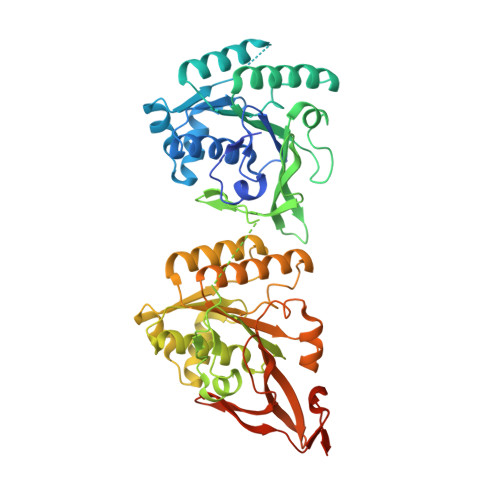Highly sensitive tryptophan fluorescence probe for detecting rhythmic conformational changes of KaiC in the cyanobacterial circadian clock system.
Mukaiyama, A., Furuike, Y., Yamashita, E., Akiyama, S.(2022) Biochem J 479: 1505-1515
- PubMed: 35771042
- DOI: https://doi.org/10.1042/BCJ20210544
- Primary Citation of Related Structures:
7WDC - PubMed Abstract:
KaiC, a core protein of the cyanobacterial circadian clock, consists of an N-terminal CI domain and a C-terminal CII domain, and assembles into a double-ring hexamer upon binding with ATP. KaiC rhythmically phosphorylates and dephosphorylates its own two adjacent residues Ser431 and Thr432 at the CII domain with a period of ∼24 h through assembly and disassembly with the other clock proteins, KaiA and/or KaiB. In this study, to understand how KaiC alters its conformation as the source of circadian rhythm, we investigated structural changes of an inner-radius side of the CII ring using time-resolved Trp fluorescence spectroscopy. A KaiC mutant harboring a Trp fluorescence probe at a position of 419 exhibited a robust circadian rhythm with little temperature sensitivity in the presence of KaiA and KaiB. Our fluorescence observations show a remarkable environmental change at the inner-radius side of the CII ring during circadian oscillation. Crystallographic analysis revealed that a side chain of Trp at the position of 419 was oriented toward a region undergoing a helix-coil transition, which is considered to be a key event to allosterically regulate the CI ring that plays a crucial role in determining the cycle period. The present study provides a dynamical insight into how KaiC generates circadian oscillation.
- Research Center of Integrative Molecular Systems (CIMoS), Institute for Molecular Science, National Institutes of Natural Sciences, 38 Nishigo-Naka, Myodaiji, Okazaki 444-8585, Japan.
Organizational Affiliation:


















